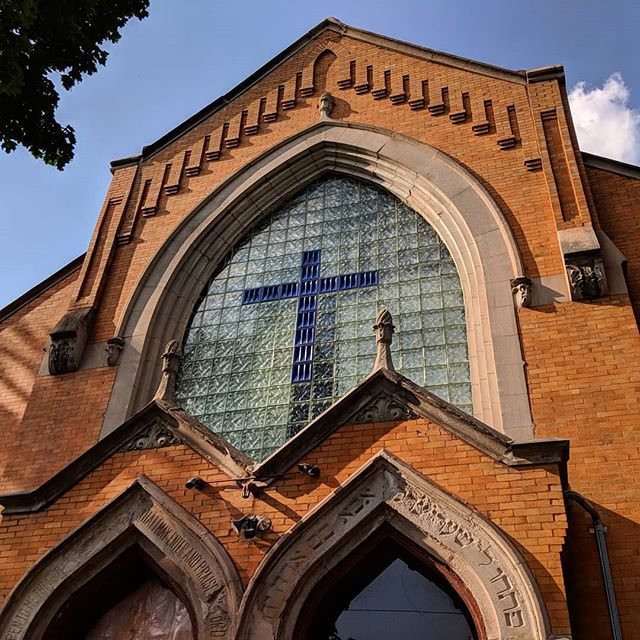

Childs Development purchased the historic synagogue/church building at 2122 W. Crystal Street in Wicker Park for $1.75 million. The purchase closed on August 8, 2018. Twelve days later on August 20, 2018, a demolition permit was issued for the 116 year-old structure. Built in 1902 as Temple Beth-El, it became the Original New Morning Star M. B. Church in the 1970’s.
Demolition and new construction developers are typically able and willing to outspend buyers looking to live and restore historic homes. According to the listing broker, the church initially asked $1.1 million for the building. It went under contract in less than a week and for an amount $650k over the list price, or approximately a 60% premium over list. The developer plans to building a high-end, six-unit condominium building with prices ranging from approximately $700k to $1 million per unit.
As reported in Block Club Chicago, the site was of particular interest to the developer as it is 14 feet wider than the standard 50 foot double lot. The location is just beyond the boundaries of the highly sought after Wicker Park Landmark District, so the Landmark District provides no protections for this building. Additionally, developers know that protected historic landmark districts are highly-desirable and add value, so if they develop close to, but just outside of historic landmark districts, they benefit from the high-desirability but without any restrictions.
Preservation Chicago has been outreaching to the developer to encourage the reuse of the façade or even part of the façade in their new construction. By saving and reusing the façade, it could replace the planned stairwell facade in the new construction and have minimal impact on the proposed condo units. The rendering of the proposed new construction shows a contemporary, but highly generic building. The historic facade would provide an authenticity and uniqueness to the building which will increase sales desirability. It would demonstrate a high respect for the history of the site, Crystal Street, and the Wicker Park Community. Smart developers have recognized that goodwill with the immediate neighbors during construction is a valuable asset.
As this development is “as-of-right”, there are few planning tools available to the community. There is no zoning change required therefore Aldermanic approval is not required. The building is not protected by any landmark designation or even included in the CHRS which could require an 90-Day Demolition Delay. Downzoning properties to have zoning better harmonized with the current existing build stock would help to encourage reuse of existing building and homes. A Chicago Landmark District would provide the greatest protections and planning and development oversight for historic structures like Temple Beth-El.
The history of the Temple Beth-El building is evident on its highly intact façade including its decorative yellow brick work, a series of limestone gothic-arches, limestone ornamentation and finials, and the Hebrew and English carved inscriptions over the front door. The only noteworthy loss to the façade was the replacement of the original stained glass windows with glass block.
The adjacent Temple Beth-El school building at 2126 W. Crystal Street was successfully adaptively reused and converted to condominiums. Directly across the street the 1890’s Lutheran gothic revival church by architects Worthmann & Steinbach at 2127 W. Crystal Street from a smiliar time period is listed as orange rated in the Chicago Historic Resources Survey (CHRS). Other than the glass block, it’s unclear why a highly intact, architecturally distinct building such as 2122 W. Crystal Street would have been overlooked by the CHRS, but provides yet another example of the limitations of the CHRS which dates from 1996.
Founded in 1871, Temple Beth-El is one of Chicago’s oldest congregations and was highly innovative throughout its history, including being one of the first to offer coed enrollment at the religious school on Crystal Street and was one of the first Chicago synagogue in Chicago to offer Sunday school education to girls. It hosted a wide-range of cultural activities including drama club performances, musical and literary events learning sessions, dances and mixers, and athletic competitions.
Per Temple Beth-El’s history website, “In 1902, the temple purchased three adjoining lots at Crystal Street and Hoyne Avenue. There they constructed a much larger building for worship as well as a separate structure with a gymnasium and rooms for a Sunday school. Such a configuration was novel to Chicago; Beth El became the first synagogue in the city to house its religious school and its sanctuary in independent buildings.”
“Ever the innovator, Rabbi Rappaport went several steps further in offering coed enrollment at the school on Crystal Street. Beth El is thus noted as the first synagogue in Chicago to offer Sunday school education to girls. Rappaport’s strong commitment to family life touched other areas of his rabbinate as well; he established Chicago’s first synagogue youth group and Beth El’s first social club for married couples.”
“With a generous gift from the Molner family, the synagogue dedicated its secondary structure as Molner Hall, and throughout Rabbi Rappaport’s tenure, Molner Hall was considered a great social hub for the Jews of the Northwest Side. Molner Hall functioned like a miniature Chicago Hebrew Institute , offering plentiful resources to the Jewish community at-large for study, sport, and socialization similar to the original Chicago Hebrew Institute on Blue Island Avenue near 12th Street. Similarly, Molner Hall hosted drama club performances, learning sessions, musical and literary events, dances and mixers, athletic competitions, and numerous other opportunities for cultural outreach for more than 20 years”
The Temple Beth-El congregation moved from Wicker Park to Logan Square. Their Logan Square synagogue building located at 3228 W. Palmer Boulevard was built in the 1920s and served as the Logan Square Boys and Girls Club since 1955. The building is under contract and preservation organizations are advocating for a preservation-sensitive outcome. The Temple Beth-El congregation then moved to Albany Park and ultimately moved to Northbrook in 1975.
History: A Proud Tradition of Worship, Education and Community
Turn-of-the-Century Improvements, Visions, History Project, Temple Beth-El


